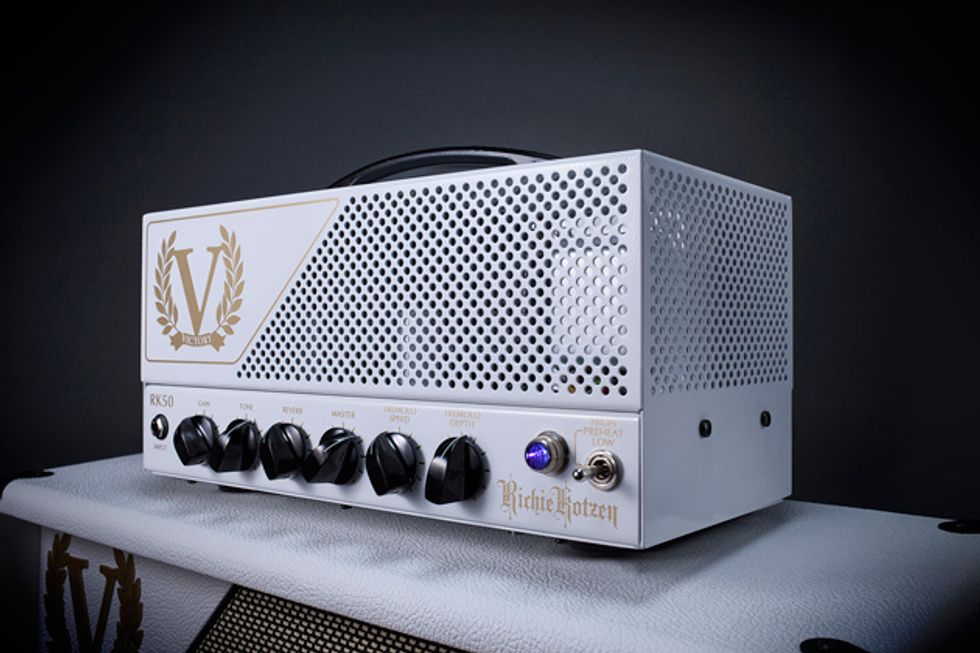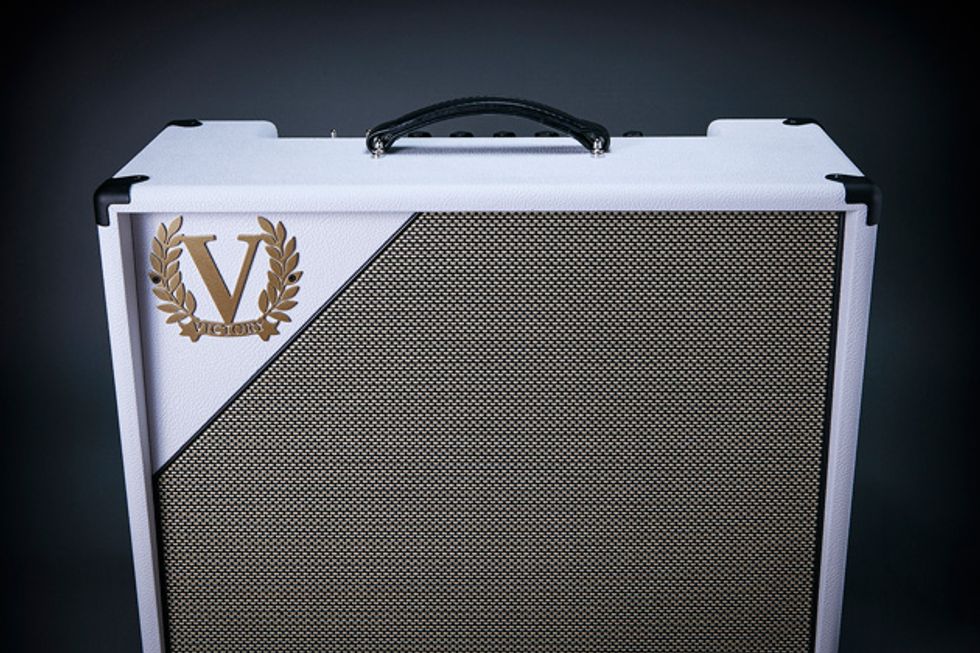United Kingdom (September 15, 2017) -- Victory Amplification from the UK proudly announces the Richie Kotzen Signature RK50 Heritage Series Combo and RK50 Compact Series Head.
This new collaboration with Richie Kotzen is a rekindling of a long-standing friendship between the celebrated American rocker and Victory Amplification chief designer, Martin Kidd.
Martin Kidd: “The initial discussions were for a unique approach to a 1x12 combo of around 40-50 watts. Richie is a big fan of the low-end response and feel you get from the power stage of a Marshall Super Lead-style circuit. For the front end, he wanted to rival his Cornford RK100 in terms of gain, yet have enough range to roll back to pushed clean and crunchy rhythm sounds. He likes to control things directly from his guitar, and also using his signature Tech 21 RK5 Fly Rig, so his only requirement in terms of gain or channel switching was a simple preamp boost that we achieved with valve gain staging.
“Likewise, he didn’t want or need extensive EQ shaping so there’s just a single ‘tone’ knob that works on the treble frequencies only. Brighter or less bright – it couldn’t be more simple! Nevertheless, given that he (and potential customers) will be using it with a variety of different cabinets, it was important to include some kind of low-end attenuation ability, so there is a ‘speaker damping’ switch on the rear panel that curbs some of the low-end resonance if you want the sound to be tighter.
“Richie also surprised us with his request for reverb and tremolo, but having developed versions of both effects for V40 The Duchess and V40 Deluxe, it was relatively simple to include these in the RK50 and really add to its appeal. In the Compact Series head the reverb is digital; in the Heritage Series combo it’s a full-length spring reverb.
“Even we’ve been surprised at how many styles the amp seems to suit, but hearing Richie play it live is where the biggest smiles happen. We are extremely proud to be behind such a brilliant and unique artist.”
Features:
- SINGLE CHANNEL PLUS BOOST & MASTER VOLUME: This deceptively simple layout offers access to a massive range of clean, breakup and full-on gained tones. The valve gain boost is footswitchable and/or selectable on the rear panel.
- SINGLE TONE: Richie wanted simplicity, so we gave him exactly that! Darker or brighter, no messing about.
- REVERB: The RK50 Combo has footswitchable spring reverb (digital in the Compact head).
- TREMOLO: The coolest guitar effect ever? Richie’s a fan and so are we: go from smooth and slow to full-on stuttering rhythms.
- HIGH & LOW POWER MODES: 50 watts high power or 9 watts low power: your choice of stage or bedroom; high headroom or more compressed dynamics.
- SERIES EFFECTS LOOP: Run your delays and reverbs – or anything else for that matter – in the loop should you so desire.
- SPEAKER DAMPING: Switches the negative feedback loop in the power section on and off. Out, there’s more bass resonance and power amp gain. Use it to optimise the amp to your chosen cabinet and/or the overall. volume. Some people just love trouser-flapping low end and some really don’t. The choice is yours.
- BIAS TEST POINTS: No more fiddling inside when you change or check output valves.
RK50 Spec
- Type: Single-channel all-valve amp with footswitchable boost, reverb and tremolo
- Features: Footswitchable boost, footswitchable reverb and tremolo. (Spring reverb in the Heritage Series Combo / digital reverb in the Compact Series head.) Speaker damping feature, high/low power options, series effects loop, option of 6L6 or EL34 power valves (including selectable bias switch)
- Power: 50 watts RMS high power, 9 watts RMS low power
- Valves: 3 x 12AX7, 2 x 6L6 (swappable for EL34)
- Speaker: 1x12-inch Celestion G12H-65 Creamback (combo)
- Sizes: Combo & 112 cabinet: 600(w) x 473(h) x 253mm(d)
- Head: 342(w) x 185(h) x 185mm(d)
- Weight: Combo: 22.3kg/49.1lbs. Head: 8.2kg/18.1lbs. 112 cab: 16kg/35lbs
- Footswitches (boost on/off and reverb & tremolo on/off) included
- Slip cover included
SRP/MAP: (September 2017)
- UK: Combo £1,649 (Compact Series Head £999)
- EU: Combo €1,869 (Compact Series Head €1,139)
- USA: Combo $1,899 (Compact Series Head $1,149)
For more information:
Victory Amplification













![Devon Eisenbarger [Katy Perry] Rig Rundown](https://www.premierguitar.com/media-library/youtube.jpg?id=61774583&width=1245&height=700&quality=70&coordinates=0%2C0%2C0%2C0)









